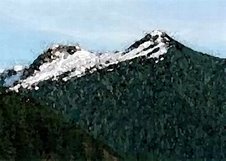Every once in a while you'll read an article in the news about a new species of tree frog or desert beetle that's been discovered, but generally speaking scientists have collected, cataloged and classified all the flora and fauna out there. But not too long ago there were entire forests, deserts and continents whose natural history was known only to the local inhabitants. There was so much potential for 'discovery' and sharing new-found knowledge among natural philosophers.
Some of this excitment and wonder has been recreated in Voyages of Discovery: a visual celebration of ten of the greatest natural history expeditions by Dr. Tony Rice.
He begins with Sir Hans Sloane's botanical collection from 1687-1689, during which time he was physician to the Governor of Jamaica (his live animal specimens did not survive the journey home to England). His collection of shells, eggs, insects and skeletons - along with the carefully pressed leaves and plants of Jamaica - formed the bulk of the British Museum when it was founded a few months after his death.
Rice also documents expeditions to Ceylon, Surinam, North America, Australia, the Amazon and the Pacific Rim that took place between 1672 and 1862. Each chapter is filled with the detailed drawings, maps, sketches and specimens that were brought back by the traveling scientists. One of the most beautiful collections in the book is from Surinam, and the background story is one of the most interesting.
Maria Sibylla Merian was 52 when she and her daughter set sail on a 2-month voyage to Surinam. Women did not often travel without male escorts in the 17th century, and few Europeans made the dangerous journey to South America. But in order to accurately depict the flora and fauna of this Dutch colony, Merian needed to see them alive and in situ. What makes Merian special is the delicacy and skill with which she recorded her natural specimens. Beautifully colored and intricately detailed, each plate is a work of art. Carl Linnaeus was so impressed with the accuracy of her work that he based part of his opus Systema Naturae solely on her observations.
This book is well-suited for artists, historians, and anyone with an interest in nature. The text is interesting and the artwork is inspiring.
Wednesday, May 27, 2009
Subscribe to:
Post Comments (Atom)

No comments:
Post a Comment